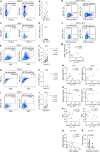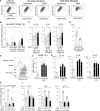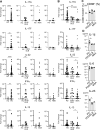α-Synuclein orchestrates Th17 responses as antigen and adjuvant in Parkinson's disease
- PMID: 39934862
- PMCID: PMC11816547
- DOI: 10.1186/s12974-025-03359-w
α-Synuclein orchestrates Th17 responses as antigen and adjuvant in Parkinson's disease
Abstract
Recently, the role of T cells in the pathology of α-synuclein (αS)-mediated neurodegenerative disorders called synucleinopathies, including Parkinson's disease (PD), dementia with Lewy bodies (DLB), and multiple system atrophy, has attracted increasing attention. Although the existence of αS-specific T cells and the immunogenicity of the post-translationally modified αS fragment have been reported in PD and DLB, the key cellular subset associated with disease progression and its induction mechanism remain largely unknown.Peripheral blood mononuclear cells (PBMCs) from synucleinopathy patients and healthy controls were cultured in the presence of the αS peptide pools. Cytokine analysis using culture supernatants revealed that C-terminal αS peptides with a phosphorylated serine 129 residue (pS129), a feature of pathological αS aggregates, promoted the production of IL-17A, IL-17F, IL-22, IFN-γ and IL-13 in PD patients compared with that in controls. In pS129 peptide-reactive PD cases, Ki67 expression was increased in CD4 T cells but not in CD8 T cells, and intracellular cytokine staining assay revealed the existence of pS129 peptide-specific Th1 and Th17 cells. The pS129 peptide-specific Th17 responses, but not Th1 responses, demonstrated a positive correlation with the Movement Disorder Society-Unified Parkinson's Disease Rating Scale (MDS-UPDRS) Part III scores. A similar correlation was observed for IL-17A levels in the culture supernatant of PBMCs from PD patients with disease duration < 10 years. Interestingly, enhanced Th17 responses to pS129 peptides were uniquely found in PD patients among the synucleinopathies, suggesting that Th17 responses are amplified by certain mechanisms in PD patients. To investigate such mechanisms, we analyzed Th17-inducible capacity of αS-exposed dendritic cells (DCs). In vitro stimulation with αS aggregates generated Th17-inducible DCs with IL-6 and IL-23 production through the signaling of TLR4 and spliced X-box binding protein-1 (XBP1s). In fact, the levels of IL-6 and IL-23 in plasma, and the XBP1s ratio in type 2 conventional DCs were increased in PD patients compared with those in controls.Here, we propose the importance of αS-specific Th17 responses in the progression of PD and the underlying mechanisms inducing Th17 responses. These findings may provide novel therapeutic strategies to prevent disease development through the suppression of TLR4-XBP1s-IL-23 signaling in DCs.
Keywords: IL-23; TLR 4; spliced X-box binding protein; synucleinopathy; α-synuclein specific T cells.
© 2025. The Author(s).
Conflict of interest statement
Declarations. Ethics approval and consent to participate: This study was approved by the Ethics Committee of Juntendo University (no. 2021100). Written informed consent was obtained from all participants before enrollment. Consent for publication: Not applicable. Competing interests: Outside of the submitted work, NH received grants from Asahi Kasei Medical Co., Ltd., SNBL, Ltd., FP Corp., and Eisai Co., Ltd.; funds for contract research from Cell Source Co., Ltd., MJFF, and MDS; and reports donations to the department, endowed research departments, and joint collaborative research departments from Sumitomo Pharma Co., Ltd., Otsuka Pharmaceutical, Co., Ltd., Takeda Pharmaceutical Co., Ltd., Kyowa Kirin Co., Ltd., Sunwels Co., Ltd., Eisai Co., Ltd., Nihon Medi-physics Co., Ltd., Abbott Japan LLC, AbbVie GK, Medtronic, Inc., Boston Scientific Japan K.K., Ono Pharmaceutical Co., Ltd., Mitsubishi Tanabe Pharma Co., Zebra Co., Ltd., Kowa Co., Ltd., Parkinson Laboratories Co., Ltd., and Ohara Pharmaceutical Co., Ltd.
Figures





References
-
- McGeer PL, Itagaki S, Akiyama H, McGeer EG. Rate of cell death in parkinsonism indicates active neuropathological process. Ann Neurol. 1988;24(4):574–6. 10.1002/ana.410240415. - PubMed
MeSH terms
Substances
Grants and funding
LinkOut - more resources
Full Text Sources
Medical
Research Materials
Miscellaneous

